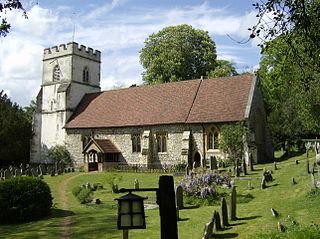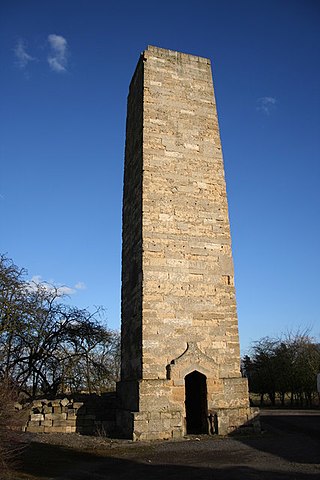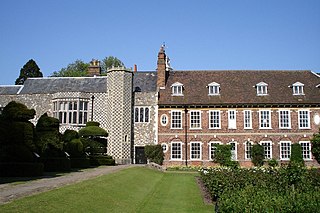
John Wilkes was an English radical journalist and politician, as well as a magistrate, essayist and soldier. He was first elected a Member of Parliament in 1757. In the Middlesex election dispute, he fought for the right of his voters—rather than the House of Commons—to determine their representatives. In 1768, angry protests of his supporters were suppressed in the Massacre of St George's Fields. In 1771, he was instrumental in obliging the government to concede the right of printers to publish verbatim accounts of parliamentary debates. In 1776, he introduced the first bill for parliamentary reform in the British Parliament.

West Wycombe is a small village and civil parish in Buckinghamshire, England, famed for its manor houses and its hills. It is 3 miles (4.8 km) west of High Wycombe.

The Hellfire Caves are a network of man-made chalk and flint caverns which extend 260m underground. They are situated above the village of West Wycombe, at the southern edge of the Chiltern Hills near High Wycombe in Buckinghamshire, Southeast England.

Medmenham is a village and civil parish in south-west Buckinghamshire, England. It is on the River Thames, about 3+1⁄2 miles (5.6 km) southwest of Marlow and 3 miles (4.8 km) east of Henley-on-Thames. The parish also includes Danesfield, a housing estate predominantly for RAF officers, although families of other ranks from the RAF, Royal Navy and British Army also live there.

West Wycombe Park is a country house built between 1740 and 1800 near the village of West Wycombe in Buckinghamshire, England. It was conceived as a pleasure palace for the 18th-century libertine and dilettante Sir Francis Dashwood, 2nd Baronet. The house is a long rectangle with four façades that are columned and pedimented, three theatrically so. The house encapsulates the entire progression of British 18th-century architecture from early idiosyncratic Palladian to the Neoclassical, although anomalies in its design make it architecturally unique. The mansion is set within an 18th-century landscaped park containing many small temples and follies, which act as satellites to the greater temple, the house.

Dunston Pillar is a Grade II listed stone tower in Lincolnshire, England and a former 'land lighthouse'. It stands beside the A15 road approximately 6 miles (10 km) south of Lincoln near the junction of the B1178, in the parish of Dunston, north of Sleaford. Closed to the public. On private land.

Francis Dashwood, 11th Baron le Despencer, PC, FRS was an English politician and rake, Chancellor of the Exchequer (1762–1763) and founder of the Hellfire Club.

Hall Place is a stately home in the London Borough of Bexley in south-east London, built in 1537 for Sir John Champneys, a wealthy merchant and former Lord Mayor of London. The house was extended in 1649 by Sir Robert Austen, a merchant from Tenterden in Kent. The house is a Grade I listed building and Scheduled Ancient Monument, and surrounded by a 65-hectare award-winning garden. It is situated on the A223, Bourne Road, south of Watling Street (A207) and north of the Black Prince interchange of the A2 dual carriageway and two lesser roads.

Philip Wharton, 1st Duke of Wharton PC was an English peer and Jacobite politician who was one of the few people in the history of England, and the first since the 15th century, to have been raised to a dukedom whilst still a minor and not closely related to the monarch.
Benjamin Edward Bates II was a British physician, art connoisseur, and socialite. Born into wealth, he was a prominent member of society and was selected to become a member of the Sir Francis Dashwood's Hellfire Club, The Monks of Medmenham. He is the great-great-grandfather of Benjamin Bates IV, founder of Bates College.

There have been two baronetcies created for members of the Dashwood family, one in the Baronetage of England and one in the Baronetage of Great Britain. Both creations are extant as of 2008.
Sir John Dashwood-King, 3rd Baronet, was an English country gentleman. Born John Dashwood, he adopted the additional surname of King by the terms of his uncle Dr. John King's will.
Sir Francis Dashwood, 1st Baronet, of St. Botolph without Bishopsgate, London, and West Wycombe, Buckinghamshire, was a British merchant, landowner and Whig politician who sat in the House of Commons from 1708 to 1713.

The Divan Club was a short-lived dining club in 18th century England, with membership open to gentlemen who had visited the Ottoman Empire. The club took its name from the Turkish "divan".

Montpelier Hill is a 383-metre hill in County Dublin, Ireland. It is topped by the Hell Fire Club, the popular name given to the ruined building. This building – an occasional summer residence built in around 1725 by William Conolly – was originally called Mount Pelier and since its construction the hill has also gone by the same name. The building and hill were respectively known locally as 'The Brass Castle' and 'Bevan's Hill', but the original Irish name of the hill is no longer known although the historian and archaeologist Patrick Healy has suggested that the hill is the place known as Suide Uí Ceallaig or Suidi Celi in the Crede Mihi, the twelfth-century diocesan register book of the Archbishops of Dublin.

The Hellfire Club is a 1961 film inspired by the historical Hellfire Club, Sir Francis Dashwood's infamous 'gentlemen's' society of the 18th century. It starred Keith Michell and featured Peter Cushing in a cameo as enigmatic attorney Mr Merryweather.

St Lawrence's Church is a Church of England church in the parish of West Wycombe, Buckinghamshire, England. It sits on top of West Wycombe Hill in a prominent position overlooking the West Wycombe Road, and surrounding villages. West Wycombe Hill is managed by the National Trust, although the church and graveyard are owned by the Church of England. The church resides in the Chilterns Area of Outstanding Natural Beauty. St Lawrence Church and the mausoleum both occupy similar positions on top of West Wycombe Hill, and the Church tower is visible for many miles around. The top of the tower is the highest point in the Southern Chilterns and on a clear day, it is possible to see West London.

Camberley Obelisk is a brick tower at the top of a hill in Camberley, Surrey, England. The tower was built by John Norris (1721–1786) in about 1765–1770. The top section of the tower was destroyed by fire in the early 1880s. It is a Grade II listed building.
George Dashwood was an English politician who served as a Tory MP for Stockbridge.















